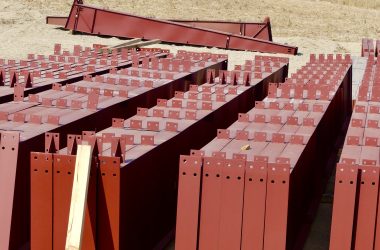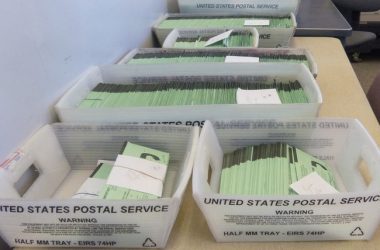Leaders at the Nyssa rail center believe that the revival of a major rail facility in eastern Washington confirms that shipping commodities is a good idea, but at the same time, its resurgence brings more uncertainties to the beleaguered Treasure Valley Reload Center project.
Union Pacific Railroad recently announced that it inked an agreement with the transportation company Tri-Cities Intermodal to acquire its specialty rail shipping facility in Wallula, Washington. The rail center, southeast of the Tri-Cities and 230 miles from Nyssa, will specialize in moving containers of commodities by rail, first to Seattle ports and then later to Chicago.
That would improve reliability and save shippers money in trucking costs, according to Ted Prince, chief executive of Tri-Cities Intermodal. The Wallula facility is slated to open in three to four months, according to Prince.
The center could come back to life while the Nyssa project remains dormant with no scheduled opening.
Prince was a founder of Tiger Cool Express, the Kansas City company that took over the Wallula rail center in January but then went out of business in June. Prince said the commodities the rail center intends to ship to Chicago include apples, pears, frozen French fries and wine.
He declined to comment on the closure of Tiger Cool. However, Prince said when Tiger Cool shuttered, he found he quickly found another investor, PNW Capital, a firm based in Florida.
Prince said he has been talking to agriculture producers in eastern Oregon. While he declined to name the potential shippers, he said that Tri-Cities is talking to larger producers in and around eastern Oregon. As a startup company, he said one or two large-size shippers could significantly impact the business.
So far, he said, those conversations with potential ag shippers have been productive.
“They’re all basically waiting for us,” he said. “They’re calling us and saying ‘we’re ready to go.'”
Shawna Peterson, executive director of the Malheur County Development Corp., the public company in charge of the Nyssa project, said she had been following the latest development in Wallula. Peterson said she had spoken to one of the leaders involved in the project.
According to Peterson, it’s important to note the Wallula facility was operating when the concept of the Nyssa rail facility was developed in 2018.
Organizers at the time represented that thousands of truckloads of onions were leaving Malheur County for the Washington depot only to pass back through on trains. That wasn’t ever the case, project officials later conceded.
The Nyssa rail reload center was touted as a significant economic boost for Malheur County, where onions would be trucked in and loaded onto trains for shipment across the country.
In May 2020, when Union Pacific closed the Wallula facility, the board of the Nyssa reload center speculated the closure could attract commodities from across the Northwest.
“I think it is pretty much across the board of people who are looking at this positively from our area,” said Grant Kitamura, president of the development corporation during a 2020 board meeting.
Last week, Kitamura didn’t respond to multiple requests for comment.
In 2020, producers and agriculture executives in the region said they would only be interested if the Nyssa development could offer expedited rail service.
While Union Pacific pledged in 2019 to provide service to the Nyssa rail facility, it couldn’t guarantee to ship onions at peak times and to reach all destinations. It offered its basic rail service, not its express package.
Nonetheless, in 2021, a report commissioned by the Oregon Department of Transportation to justify funding for the rail center noted that Union Pacific’s decision to shutter the Wallula shipping center freed up refrigerated rail cars for the Nyssa project.
The idea behind the publicly-financed rail shipping center is that it would cut costs for onion shippers that rely on expensive trucking or unreliable rail service to their packing plants. The partnership between the onion shippers, the national warehousing company Americold and Union Pacific Railroad would also open new markets for the onion industry.
Project officials said the public would benefit by taking trucks off Oregon highways, cutting down the need for maintenance and reducing crashes. That was based on calculations the truck traffic was then going to Wallula. No update has ever been done to newly assess the public benefits from government investment in Nyssa.
Americold, the original operator for the facility, pulled out of the project in July. Americold notified rail project leaders the shipping depot was not “financially viable” for the company.
Peterson, who took over as executive director earlier this year, noted that Tri-Cities Intermodal’s acquisition of the Wallula facility would factor into projected volumes for the Nyssa rail center as the development corporation devises a new business plan.
In September, the state Transportation Department notified the Nyssa reload center’s leaders that it planned to hold back the $8 million set aside for the rail center until project leaders found a new operator for the facility and developed a new financial plan. So far, the state has sunk $25 million into the project, which had been slated to be online by the fall of 2020, followed by multiple opening dates that have come and gone.
Now, the state is considering whether to continue to support the project or find a way to recoup the $25 million in public money it has invested.
With roughly three miles of partially built rail lines and a steel building that sits in pieces at the site, Peterson told the Enterprise in September that she is mulling what else the reload center could be used for. Inbound commodities, she said, could be “a promising business plan angle.”
Peterson said she wants to learn if freight trucked into warehouses along Interstate 84 between Boise and Ontario could instead go by less-costly rail to Nyssa and then be trucked shorter distances.
According to Prince, eastern Oregon could become a global logistics center. Prince said 40 years ago Walmart had about ten distribution centers nationwide. According to Walmart’s website, there are more than 200.
Prince said the reason for that is because the model used to be that distribution centers needed to be no more than 300 miles from each retail store. But today, he said, with E-commerce, the distribution center is also the fulfillment center, a warehouse where orders are packed and shipped to fulfill orders, especially those made by customers online. Prince said E-commerce centers now need to be within 50 miles of customers to provide expected rapid delivery.
Eastern Washington and Oregon are “uniquely” designed to drive the shift from truck to rail.
“You can shuttle everything out by rail,” he said. “You’ve got labor, land, you have electricity and water. There’s nowhere else that has that unique combination.”
News tip? Contact reporter Steven Mitchell at [email protected]
HOW TO SUBSCRIBE – The Malheur Enterprise delivers quality local journalism – fair and accurate. You can read it any hour, any day with a digital subscription. Read it on your phone, your Tablet, your home computer. Click subscribe – $7.50 a month.




